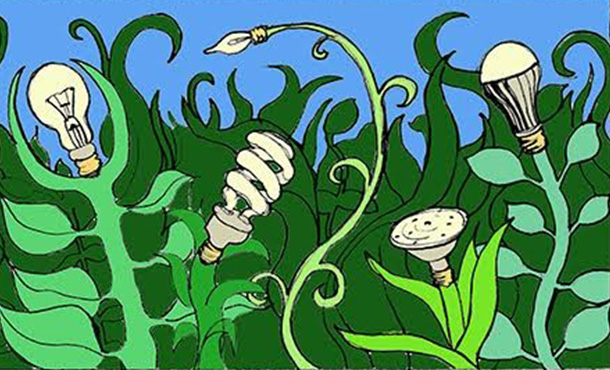
Creativity, Innovation and Change, now available on Coursera, is a Massive Open Online Course available free to the public. The course was developed by faculty members within the College of Engineering and aims to discover and promote the utilization of every individual's unique creative potential.
Penn State engineering professors cultivate creativity worldwide
8/04/2015
Although creativity is most often associated with the arts, being creative is really about thinking differently and taking action in innovative ways, something that can provide an edge in almost any field. Four faculty members from Penn State felt creativity was so essential, in fact, that they joined forces to develop an entire course around the concept.
The faculty members wanted to create something that could have a far-reaching impact, so they developed a Massive Open Online Course (MOOC) and worked with Coursera to offer it free to students around the world.
The concept for the eight-week MOOC titled, “Creativity, Innovation, and Change” (CIC), began in 2013. Jack Matson, professor emeritus of environmental engineering, recruited Darrell Velegol, distinguished professor of chemical engineering, and Kathryn Jablokow, associate professor of mechanical engineering and engineering design, to help him design and teach the MOOC.
“I didn’t really know what a MOOC was, but it sounded like a lot of work,” said Velegol, who initially turned Matson down but soon changed his mind when he realized this was the opportunity he had been looking for.
Jablokow had a similar reaction: “I jumped in without really knowing what I was getting myself into, but it felt like an opportunity I couldn’t refuse.”
The College of Engineering was also very supportive of the MOOC, as was Penn State’s Office of Outreach and Online Education. Velegol said both former Penn State President Rodney Erickson and Harold and Inge Marcus Dean of Engineering Amr Elnashai made videos to support the course.
As the newly assembled threesome began to develop the content for the course, they realized they needed a team to help them and the guidance of others whose expertise would build on their own. One of the most influential was Susan Russell, associate professor of theater and recent Penn State Laureate. Russell taught the instructors how to effectively engage their audience using video modules.
“She was emphatic that our job was not simply to convey content -- our real job was to instigate and provoke,” Velegol said. “Simplify, clarify and focus -- those were her three words.”
Although the team had previously used active learning techniques, they learned through Russell to replace almost all lecture with inviting dialogue. As a result, they created scripts and performed the content like a television show.
“Even the ‘spontaneous moments’ needed to be scripted,” Velegol said.
Jablokow said they started with 40-minute scripts, which Russell influenced them to cut again and again.
“It was an incredibly challenging exercise in boiling down each message into something very concise – a new skill that I now use in my resident classroom,” Jablokow explained.
In the end, it took the team more than a thousand hours each to finish the content, which included six lesson modules. Each of the lessons was comprised of short videos, reading materials, exercises and discussion forums.
“That is at least five times the number of hours that I would ordinarily put into a class,” Velegol said.
Fortunately, their long hours paid off. The wildly popular eight-week course, launched in 2013 by Coursera, enrolled more than 130,000 students from 190 different countries, making it among Coursera’s 10 most attended courses ever.
The following year, Elizabeth Kisenwether, assistant professor of engineering design and director of the Intercollege Minor in Entrepreneurship and Innovation, was added to the lineup and the course was truncated to six weeks. For the first time, the course was also offered in Chinese as well as English.
“China had the largest student group from any country,” Matson said. “They exceeded the United States.”
He said the Chinese version of the course attracted a different demographic than the English course had.
“For the first course, the average age was 37. Many of the students had college degrees and were taking it to improve their own creativity,” Matson said. “For the Chinese course, the average age was 21. These students were taking it to improve their skills for the job market.”
Creativity in engineering
The course creators strongly believe that creativity is something we are all born with, and, like any other subject, creativity can also be taught. But beyond some creativity nurturing that happens in elementary school, it’s very rarely taught, even to engineers.
“One of the myths this course addresses is that you’re either creative or you’re not and that we, as engineers, are not,” said Velegol.
Conversely, successful engineers are people who think creatively both inside and outside the box to develop solutions to everyday problems. They come up with ideas that often change the way we think about the world – sometimes incrementally and sometimes radically. In addition, engineers are often entrepreneurs, and innovation is the basis of entrepreneurship, so being able to think and act creatively is incredibly important.
“Creativity comes in many different shapes and sizes,” said Jablokow, “and we teach students to recognize and appreciate that creative diversity in this MOOC.”
Matson, Velegol, Kisenwether and Jablokow have a long history with creativity. Each of them has been incorporating creativity into their engineering courses for more than 15 years. They understand the huge competitive edge that students gain from learning about creativity.
Matson, the initiator for the MOOC project, came to recognize creative potential after sustaining a life threatening lightning strike three decades ago. He used creativity to recover from his injury and made it his mission to bring creativity into the classroom.
“How can I get metaphorical lightning strikes to our students?” Matson asked. It took many failures for him to get his students to see the benefit of focusing on more than just solving an equation and getting a good grade.
“If you’re not using your creative potential, it’s a waste,” Matson said. “I’m an environmental engineer, so when you think of waste, you think of many different things, but to me, a waste of creative potential is the biggest waste of all.”
All of the instructors share in Matson’s passion for developing and using creative potential. The team admits to using many of the creativity concepts taught in the course as part of their day-to-day instruction at Penn State.
The next phase
For the upcoming 2015 CIC offering, the instructors partnered with Armend Tahirsylaj, a recent doctoral graduate in education policy at Penn State, and John Bellanti, a psychologist and life coach in State College, to improve the course even more.
Although the pair has been involved with the course since the beginning, they will now be featured in their own module concerning psychological changes and creativity. This new module focuses on “the freedom to learn freely” by following the belief that individuals must focus on what is unique about their own lives rather than what they have in common with others.
Another new feature will be on demand learning.
The previous courses had a particular start and stop time, said Velegol. “We will now engage in what is called ‘on demand’ learning, which means students can stop whenever they want and start whenever they want asynchronously.”
This on demand feature allows much more flexibility for its users; however, it also requires more effort on the instructors’ part.
“It’s an even deeper automation of the course, so it requires a lot more logistics and a lot more from us as faculty,” said Velegol. “Exercises have to be very clearly defined, the grading rubric has to be very clearly defined—there’s a lot of specificity.”
Although engineers created the course, the MOOC is open to anyone, and the concepts apply to any field of study. Students in the MOOC learn concepts such as intelligent fast failure, which encourages students to learn by running many small experiments. Most will fail, but each failure will result in some new piece of knowledge. Another concept, mastering the luck, promotes the notion that great ideas can happen serendipitously – especially when students learn to see and pay attention to these chance happenings wherever they are. A third concept, bold acts of defiance, asks students to defy a cultural norm in order to understand the associated anxiety of introducing a new idea that may be rejected by others.
The implications of CIC are as varied as they are far reaching. The course has inspired a countless number of individuals from across the globe to achieve success in creative pursuits. Some have harnessed their newfound abilities to enhance their personal lives and careers, while others have gone on to pursue entrepreneurial endeavors including business and philanthropic ventures.
“I was interested in the study of creativity long before I subscribed to CIC,” stated Andreea Pavel, a former CIC student from Tulcea, Romania. Shortly after joining the course, I reached out to Jack Matson, who helped me understand my creative mind. I was enamored with discovering the psychology behind creativity and how people can develop their full potential.”
Today, Pavel continues to study creativity and works to help others improve their daily lives by fulfilling their creative potential.
A host of other success stories similar to Pavel’s exist on the CIC blog Play at Creation. The blog documents a number of individual creative journeys that have been born from the CIC course. They include perspectives on everything from personal transformations to efforts to re-green the Nilgiri Hills in India.
Effects of the course have also transcended beyond the individual level.
In 2014, Matson and Velegol were invited to speak at the EPIC Congress in France to support the “Reinvent Europe” movement. The duo discussed invigorating new business interests and incorporating new ideas into the political arena.
“There have been so many amazing outputs from the course,” Velegol said. “The books people have sent, the businesses that have been started. We hear things from all over the world like ‘because of your course we have achieved our goals.’”
The new format of CIC is available now and open to everyone. Those interested in registering for the on demand course may do so at https://www.coursera.org/learn/creativity-innovation.



